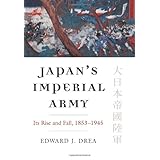
Average Reviews:

(More customer reviews)Are you looking to buy Japan's Imperial Army: Its Rise and Fall, 1853-1945 (Modern War Studies Series)? Here is the right place to find the great deals. we can offer discounts of up to 90% on Japan's Imperial Army: Its Rise and Fall, 1853-1945 (Modern War Studies Series). Check out the link below:
>> Click Here to See Compare Prices and Get the Best Offers
Japan's Imperial Army: Its Rise and Fall, 1853-1945 (Modern War Studies Series) ReviewIt has taken more than six decades after its fall, but at last we have a fine, well-written, well-informed English-language history of the army of imperial Japan. Given the central role that the Japanese Army played in the history of Japan and East Asia generally for half a century, it is remarkable that it has taken so long, but we can be thankful for the result.The book is superbly balanced and remarkably inclusive. Military, political, social, and economic aspects -- they are all there. It is all somewhat more condensed than one might wish -- an editorial choice, no doubt, rather than any limitation of Drea's knowledge. But the bibliography and notes provide a comprehensive guide to sources both in Japanese and English.
This is a very accessible book. The author provides a framework of historical background that can guide readers not familiar with the details of Japan's history, but does so in a graceful fashion that will not get in the way of those who know Japan better. In particular, readers who simply want to understand the Asian part of World War II clearly should find it easy and fascinating reading.
There is absolutely no way to understand the history of modern Japan without understanding the Japanese Army, and no other book on the Japanese Army in English that can begin to compare with this one.
There is a book of more or less equivalent excellence about the Japanese Navy, Kaigun: Strategy, Tactics, and Technology in the Imperial Japanese Navy, 1887-1941. But the navy was never as central to Japanese strategy or politics as the army -- the army really drove the train and Drea tells us how. It is best to read this book first, and then go on to the navy.
With the Chinese sounding steadily more like Japan in the late 1920s, this book could scarcely be more timely.Japan's Imperial Army: Its Rise and Fall, 1853-1945 (Modern War Studies Series) OverviewPopular impressions of the imperial Japanese army still promote images of suicidal banzai charges and fanatical leaders blindly devoted to their emperor. Edward Drea looks well past those stereotypes to unfold the more complex story of how that army came to power and extended its influence at home and abroad to become one of the world's dominant fighting forces.This first comprehensive English-language history of the Japanese army traces its origins, evolution, and impact as an engine of the country's regional and global ambitions and as a catalyst for the militarization of the Japanese homeland from mid-nineteenth-century incursions through the end of World War II. Demonstrating his mastery of Japanese-language sources, Drea explains how the Japanese style of warfare, burnished by samurai legends, shaped the army, narrowed its options, influenced its decisions, and made it the institution that conquered most of Asia. He also tells how the army's intellectual foundations shifted as it reinvented itself to fulfill the changing imperatives of Japanese society--and how the army in turn decisively shaped the nation's political, social, cultural, and strategic course.Drea recounts how Japan devoted an inordinate amount of its treasury toward modernizing, professionalizing, and training its army--which grew larger, more powerful, and politically more influential with each passing decade. Along the way, it produced an efficient military schooling system, a well-organized active duty and reserve force, a professional officer corps that thought in terms of regional threat, and well-trained soldiers armed with appropriate weapons.Encompassing doctrine, strategy, weaponry, and civil-military relations, Drea's expert study also captures the dominant personalities who shaped the imperial army, from Yamagata Aritomo, an incisive geopolitical strategist, to Anami Korechika, who exhorted the troops to fight to the death during the final days of World War II. Summing up, Drea also suggests that an army that places itself above its nation's interests is doomed to failure.This book is part of the Modern War Studies series.
Want to learn more information about Japan's Imperial Army: Its Rise and Fall, 1853-1945 (Modern War Studies Series)?
>> Click Here to See All Customer Reviews & Ratings Now
0 comments:
Post a Comment